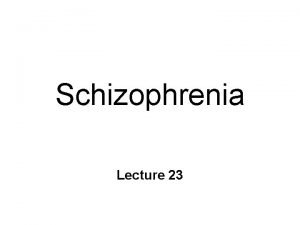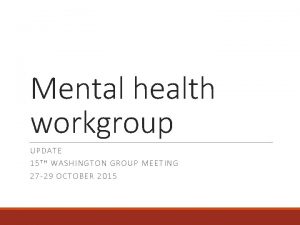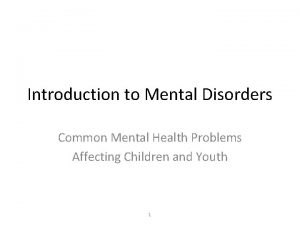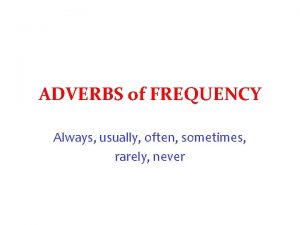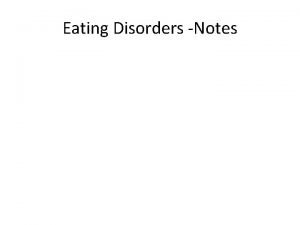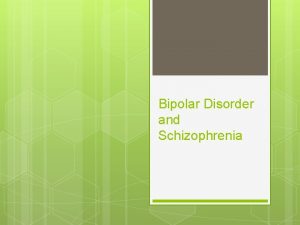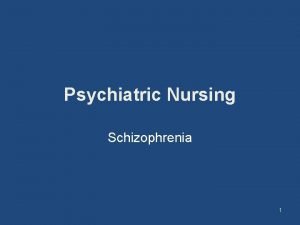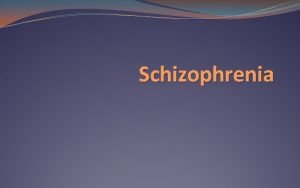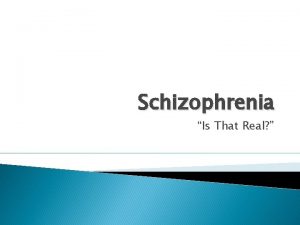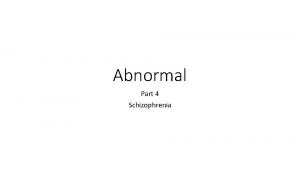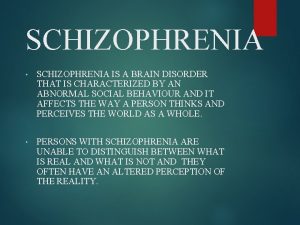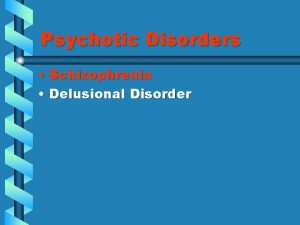Schizophrenia Schizophrenia is a mental disorder often characterized












- Slides: 12

Schizophrenia

�Schizophrenia is a mental disorder often characterized by abnormal social behavior and failure to recognize what is real. Common symptoms include false beliefs, unclear or confused thinking, auditory hallucinations, reduced social engagement and emotional expression, and inactivity. Diagnosis is based on observed behavior and the person's reported experiences.

�Symptoms � Self-portrait of a person with schizophrenia, representing that individual's perception of the distorted experience of reality in the disorder � Individuals with schizophrenia may experience hallucinations (most reported are hearing voices), delusions (often bizarre or persecutory in nature), and disorganized thinking and speech. The last may range from loss of train of thought, to sentences only loosely connected in meaning, to speech that is not understandable known as word salad in severe cases. Social withdrawal, sloppiness of dress and hygiene, and loss of motivation and judgment are all common in schizophrenia. There is often an observable pattern of emotional difficulty, for example lack of responsiveness. Impairment in social cognition is associated with schizophrenia, as are symptoms of paranoia. Social isolationcommonly occurs. Difficulties in working and long-term memory, attention, executive functioning, and speed of processing also commonly occur. In one uncommon subtype, the person may be largely mute, remain motionless in bizarre postures, or exhibit purposeless agitation, all signs of catatonia. About 30 to 50% of people with schizophrenia fail to accept that they have an illness or their recommended treatment. Treatment may have some effect on insight. People with schizophrenia often find facial emotion perception to be difficult.

� Positive and negative symptoms Schizophrenia is often described in terms of positive and negative (or deficit) symptoms. Positive symptoms are those that most individuals do not normally experience but are present in people with schizophrenia. They can include delusions, disordered thoughts and speech, and tactile, auditory, visual, olfactory and gustatory hallucinations, typically regarded as manifestations of psychosis. Hallucinations are also typically related to the content of the delusional theme. Positive symptoms generally respond well to medication. � Negative symptoms are deficits of normal emotional responses or of other thought processes, and respond less well to medication. They commonly include flat expressions orlittle emotion, poverty of speech, inability to experience pleasure, lack of desire to form relationships, and lack of motivation. Negative symptoms appear to contribute more to poor quality of life, functional ability, and the burden on others than do positive symptoms. People with greater negative symptoms often have a history of poor adjustment before the onset of illness, and response to medication is often limited. [ �

Onset � Late adolescence and early adulthood are peak periods for the onset of schizophrenia, [4] critical years in a young adult's social and vocational development. [20] In 40% of men and 23% of women diagnosed with schizophrenia, the condition manifested itself before the age of 19. [21] To minimize the developmental disruption associated with schizophrenia, much work has recently been done to identify and treat the prodromal (pre-onset) phase of the illness, which has been detected up to 30 months before the onset of symptoms. [20] Those who go on to develop schizophrenia may experience transient or self-limiting psychotic symptoms[22] and the non-specific symptoms of social withdrawal, irritability, dysphoria, [23] and clumsiness[24] during the prodromal phase.

Causes � A combination of genetic and environmental factors play a role in the development of schizophrenia. People with a family history of schizophrenia who have a transient psychosis have a 20– 40% chance of being diagnosed one year later. � Genetic causes: � Estimates of heritability vary because of the difficulty in separating the effects of genetics and the environment; [26] averages of 0. 80 have been given. [27] The greatest risk for developing schizophrenia is having afirstdegree relative with the disease (risk is 6. 5%); more than 40% of monozygotic twins of those with schizophrenia are also affected. [1] If one parent is affected the risk is about 13% and if both are affected the risk is nearly 50%

Substance use causes About half of those with schizophrenia use drugs or alcohol excessively. [37] Amphetamine, cocaine, and to a lesser extent alcohol, can result in psychosis that presents very similarly to schizophrenia. [1][38] Although it is not generally believed to be a cause of the illness, people with schizophrenia use nicotine at much greater rates than the general population. [39] � Alcohol abuse can occasionally cause the development of a chronic substance-induced psychotic disorder via a kindling mechanism. [40] Alcohol use is not associated with an earlier onset of psychosis. [41] � A significant proportion of people with schizophrenia use cannabis to help cope with its symptoms. [37] Cannabis can be a contributory factor in schizophrenia, [42][43][44] but cannot cause it alone; [44] its use is neither necessary nor sufficient for development of any form of psychosis. [44] Early exposure of the developing brain to cannabis increases the risk of schizophrenia, [42] although the size of the increased risk is difficult to quantify; [42][43] only a small proportion of early cannabis recreational users go on to develop any schizoaffective disorder in adult life, [43] and the increased risk may require the presence of certain genes within an individual[44] or may be related to preexisting psychopathology. [42] Higher dosage and greater frequency of use are indicators of increased risk of chronic psychoses. [43] Tetrahydrocannabinol (THC) and cannabidiol(CBD) produce opposing effects; CBD has antipsychotic and neuroprotective properties and counteracts negative effects of THC. [43] � Other drugs may be used only as coping mechanisms by individuals who have schizophrenia to deal with depression, anxiety, boredom, and loneliness. � �

Diagnosis Main article: Diagnosis of schizophrenia John Nash, an Americanmathematician and joint winner of the 1994 Nobel Prize for Economics, who had schizophrenia. His life was the subject of the 2001 Academy Award-winning film. A Beautiful Mind. � Schizophrenia is diagnosed based on criteria in either the American Psychiatric Association's fifth edition of the Diagnostic and Statistical Manual of Mental Disorders (DSM 5), or the. World Health Organization's International Statistical Classification of Diseases and Related Health Problems (ICD-10). These criteria use the self-reported experiences of the person and reported abnormalities in behavior, followed by a clinical assessment by a mental health professional. Symptoms associated with schizophrenia occur along a continuum in the population and must reach a certain severity before a diagnosis is made. [1] As of 2013 there is no objective test. � �

Prevention � Prevention of schizophrenia is difficult as there are no reliable markers for the later development of the disease. [80] The evidence for the effectiveness of early interventions to prevent schizophrenia is inconclusive. [81]While there is some evidence that early intervention in those with a psychotic episode may improve short-term outcomes, there is little benefit from these measures after five years. [4] Attempting to prevent schizophrenia in the prodrome phase is of uncertain benefit and therefore as of 2009 is not recommended. [82] Cognitive behavioral therapy may reduce the risk of psychosis in those at high risk after a year [83] and is recommended by the National Institute for Health and Care Excellence (NICE) in this group. [84] Another preventative measure is to avoid drugs that have been associated with development of the disorder, includingcannabis, cocaine, and amphetamines.

Epidemiology Schizophrenia affects around 0. 3– 0. 7% of people at some point in their life, [4] or 24 million people worldwide as of 2011. [121] It occurs 1. 4 times more frequently in males than females and typically appears earlier in men[1]—the peak ages of onset are 25 years for males and 27 years for females. [122] Onset in childhood is much rarer, [123] as is onset in middle- or old age. [124] Despite the received wisdom that schizophrenia occurs at similar rates worldwide, its frequency varies across the world, [67][125] within countries, [126]and at the local and neighborhood level. [127] It causes approximately 1% of worldwide disability adjusted life years[1] and resulted in 20, 000 deaths in 2010. [128] The rate of schizophrenia varies up to threefold depending on how it is defined. [4] � In 2000, the World Health Organization found the prevalence and incidence of schizophrenia to be roughly similar around the world, with age-standardized prevalence per 100, 000 ranging from 343 in Africa to 544 in Japan and Oceania for men and from 378 in Africa to 527 in Southeastern Europe for women. �


Sources http: //en. wikipedia. org/wiki/Schizophrenia
 Malingering
Malingering Mental disorder definition
Mental disorder definition Mental disorder definition
Mental disorder definition Causes of mental disorder
Causes of mental disorder Personality disorder vs mental illness
Personality disorder vs mental illness Always often sometimes hardly ever never
Always often sometimes hardly ever never Chapter 20 mental health and mental illness
Chapter 20 mental health and mental illness Mental health jeopardy game
Mental health jeopardy game 13 colonies outline map
13 colonies outline map Roaring 20s were characterized by
Roaring 20s were characterized by Minoan architecture is characterized by fortified citadels.
Minoan architecture is characterized by fortified citadels. Workgroups are characterized by
Workgroups are characterized by Anorexia nervosa is characterized
Anorexia nervosa is characterized

